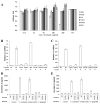Osmunda japonica Extract Suppresses Pro-Inflammatory Cytokines by Downregulating NF-κB Activation in Periodontal Ligament Fibroblasts Infected with Oral Pathogenic Bacteria
- PMID: 32244806
- PMCID: PMC7177349
- DOI: 10.3390/ijms21072453
Osmunda japonica Extract Suppresses Pro-Inflammatory Cytokines by Downregulating NF-κB Activation in Periodontal Ligament Fibroblasts Infected with Oral Pathogenic Bacteria
Abstract
Periodontal diseases are caused by bacterial infection and may progress to chronic dental disease; severe inflammation may result in bone loss. Therefore, it is necessary to prevent bacterial infection or control inflammation. Periodontal ligament fibroblasts (PDLFs) are responsible for the maintenance of tissue integrity and immune and inflammatory events in periodontal diseases. The formation of bacterial complexes by Fusobacterium nucleatum and Porphyromonas gingivalis is crucial in the pathogenesis of periodontal disease. F. nucleatum is a facultative anaerobic species, considered to be a key mediator of dental plaque maturation and aggregation of other oral bacteria. P. gingivalis is an obligate anaerobic species that induces gingival inflammation by secreting virulence factors. In this study, we investigated whether Osmunda japonica extract exerted anti-inflammatory effects in primary PDLFs stimulated by oral pathogens. PDLFs were stimulated with F. nucleatum or P. gingivalis. We showed that pro-inflammatory cytokine (IL-6 and IL-8) expression was induced by LPS or bacterial infection but decreased by treatment with O. japonica extract following bacterial infection. We found that the activation of NF-κB, a transcription factor for pro-inflammatory cytokines, was modulated by O. japonica extract. Thus, O. japonica extract has immunomodulatory activity that can be harnessed to control inflammation.
Keywords: Fusobacterium nucleatum; Osmunda japonica; Porphyromonas gingivalis; periodontal ligament fibroblast; pro-inflammatory cytokines.
Conflict of interest statement
The authors declare no conflict of interest. The funders had no role in the design of the study; in the collection, analyses, or interpretation of data; in the writing of the manuscript, or in the decision to publish the results.
Figures






Similar articles
-
Litsea japonica Leaf Extract Suppresses Proinflammatory Cytokine Production in Periodontal Ligament Fibroblasts Stimulated with Oral Pathogenic Bacteria or Interleukin-1β.Int J Mol Sci. 2018 Aug 23;19(9):2494. doi: 10.3390/ijms19092494. Int J Mol Sci. 2018. PMID: 30142971 Free PMC article.
-
NOX1/2 activation in human gingival fibroblasts by Fusobacterium nucleatum facilitates attachment of Porphyromonas gingivalis.Arch Microbiol. 2016 Aug;198(6):573-83. doi: 10.1007/s00203-016-1223-7. Epub 2016 Apr 12. Arch Microbiol. 2016. PMID: 27071620
-
Hydrogen sulfide synergistically upregulates Porphyromonas gingivalis lipopolysaccharide-induced expression of IL-6 and IL-8 via NF-κB signalling in periodontal fibroblasts.Arch Oral Biol. 2014 Sep;59(9):954-61. doi: 10.1016/j.archoralbio.2014.05.022. Epub 2014 Jun 2. Arch Oral Biol. 2014. PMID: 24927331
-
Porphyromonas gingivalis lipopolysaccharide signaling in gingival fibroblasts-CD14 and Toll-like receptors.Crit Rev Oral Biol Med. 2002;13(2):132-42. doi: 10.1177/154411130201300204. Crit Rev Oral Biol Med. 2002. PMID: 12097356 Review.
-
Immunological Pathways Triggered by Porphyromonas gingivalis and Fusobacterium nucleatum: Therapeutic Possibilities?Mediators Inflamm. 2019 Jun 24;2019:7241312. doi: 10.1155/2019/7241312. eCollection 2019. Mediators Inflamm. 2019. PMID: 31341421 Free PMC article. Review.
Cited by
-
Metronidazole and Ketoprofen-Loaded Mesoporous Magnesium Carbonate for Rapid Treatment of Acute Periodontitis In Vitro.ACS Omega. 2023 Jul 5;8(28):25441-25452. doi: 10.1021/acsomega.3c02968. eCollection 2023 Jul 18. ACS Omega. 2023. PMID: 37483201 Free PMC article.
-
Anti-Inflammatory Effect of Charantadiol A, Isolated from Wild Bitter Melon Leaf, on Heat-Inactivated Porphyromonas gingivalis-Stimulated THP-1 Monocytes and a Periodontitis Mouse Model.Molecules. 2021 Sep 17;26(18):5651. doi: 10.3390/molecules26185651. Molecules. 2021. PMID: 34577123 Free PMC article.
-
Fabrication of Mastic Gum Resin Tethered Phospholipid Nanocarriers for the Evaluation and Enhancement of Anti-inflammatory and Anti-bacterial Effects.Curr Pharm Des. 2025;31(23):1866-1876. doi: 10.2174/0113816128353794241225083428. Curr Pharm Des. 2025. PMID: 39878118
References
MeSH terms
Substances
Grants and funding
LinkOut - more resources
Full Text Sources
Medical

